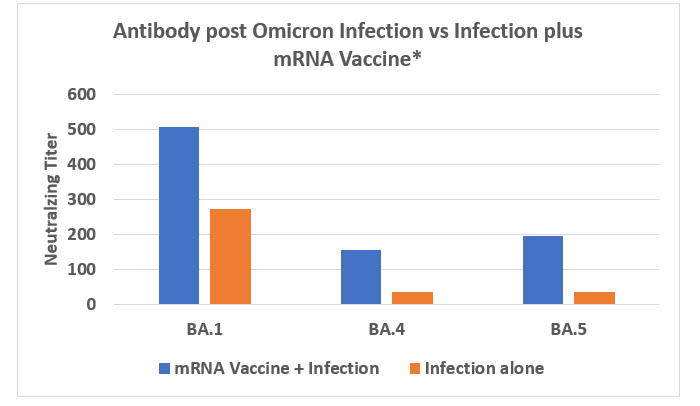Wide World of Vaccines
May 2022
Three Newer Antibody-Evading Omicron Variants Coming, Plus Pediatric COVID-19 Disease Burden So Far

Column Editor: Christopher Harrison, MD | Professor of Pediatrics, UMKC School of Medicine | Clinical Professor of Pediatrics, University of Kansas School of Medicine
It is like deja vu all over again. Dr. Fauci may have stated that we are no longer in a pandemic phase, but has anyone told the virus? Three newer Omicron variants have the ability to at least partially evade immunity produced by prior SARS-CoV-2 variant infections (including the first Omicron variant – BA.1), most monoclonal antibodies, and two- and three-dose mRNA vaccine schedules. So, how much protection is expected from four-dose mRNA vaccine-induced immunity or hybrid immunity (prior infection plus vaccine)?
It is not a question of whether but when we will see the next SARS-CoV-2 case surge in the Kansas City region. But what about increases in hospitalizations and/or deaths? As in the past, South Africa and the U.S. East Coast are acting as our canaries in the coal mine.
Omicron BA.2.12.1 The variant most likely to next reach the Midwest U.S. is BA.2.12.1. It contains new and added mutations, e.g., at L452, leading to higher transmissibility than prior Omicron variants. As of mid-May, it is responsible for the recent uptick in cases and hospitalizations in the mid-Atlantic and Northeast U.S., now comprising nearly 50% of cases in New York, New Jersey and North Carolina (<5% in March). In those same regions, case/hospitalization rates are near those of early February 2022 (the last of the original Omicron surge). Fortunately, deaths have not risen in parallel, perhaps due to 1) Omicron being innately less lethal, 2) High levels of vaccine uptake in those areas, and/or 3) Modest levels of persons seropositive from previous SARS-CoV-2 infections. Of course, we have not had enough time to see the usual four- to eight-week lag between upticks in hospitalizations and upticks in deaths. Or our treatment tools may now stave off death in hospitalized patients better than in pre-Omicron waves. We will know more about the innate virulence and death rates from BA.2.12.1 by mid-June.
Emerging data on the ability of BA.2.12.1 to evade existing infection- or vaccine-induced neutralizing antibodies suggest a 35% drop in the ability to neutralize BA.2.12.1 compared to BA.1 (the original Omicron variant) even at the peak of immunity.1 So, as people’s titers wane three to six months after the last vaccine dose or last infection (even with the original Omicron variant), another surge in cases across the U.S. will be inevitable. As BA.2.12.1 spreads, we will likely have a local BA.2.12.1 surge sometime in the next six to eight weeks. Let’s hope BA.2.12.1 is not severe in children and that deaths do not rise like they did during the original Omicron surge.
Omicron BA.4 and BA.5 While we await an expected BA.2.12.1 surge this summer, two other variants of perhaps more concern are emerging in South Africa, BA.4 and BA.5. These also have a L452 mutation (different than BA.2.12.1), rendering them more transmissible than BA.1. These two variants also share with each other another group of mutations in the spike protein that produce more intense escape from antibodies due to vaccines or prior Omicron BA.1 infections.2 BA.4 and BA.5 are different variants but are so similar that they are often grouped together as BA.4/BA.5 for discussion purposes. Nevertheless, in in vitro assays similar to those we discussed above for BA.2.12.1, neutralizing capacity of serum from unvaccinated persons who have recovered from BA.1 infection is 87% less for both BA.4 and BA.5. For mRNA vaccinees who had an Omicron BA.1 breakthrough infection, the drop in neutralizing capacity was less but notable, 69% for BA.4 and 62% for BA.5. Figure. These data suggest better protection from hybrid immunity than immunity from infection alone, but the relatively low neutralizing titers of hybrid immunity are hardly comforting. Neutralizing capability comparisons from three and four doses of mRNA vaccine alone are underway, but results will likely not be known until June. The innate virulence of BA.4 and BA.5 in South Africa so far seems to be less than Beta or Delta (increases in cases and hospitalizations but not deaths). But as we have discussed in prior columns, nearly everyone in South Africa is seropositive from a prior infection, so we may see more disease in the U.S. And no data are yet available on virulence in children.
What does all this mean? If events unfold as they have for other recent variants with mutations that convey added immune evasion and increased transmissibility, BA.2.12.1 and BA.4 and/or BA.5 will produce surges. The BA.2.12.1 surge is already underway in the U.S. The BA.4/BA.5 surge would likely be in the fall/winter of 2022. The need for another booster (dose 5 for those that have four doses as of now, or dose 4 for those who have only had three current mRNA doses) seems apparent to keep hospitalizations and deaths to a minimum. We know that boosters will not protect against breakthrough infections for more than three to six months, so our expectations need to be tempered. The best measure of the benefits of current vaccines is keeping hospitalizations and death down.
Will Omicron-specific boosters or the newer non-mRNA vaccines provide better protection than current mRNA vaccines? The short answer is we do not know, but it seems unlikely. To date, Omicron-specific vaccines are based on the BA.1 variant and have been remarkably Omicron BA.1-specific, producing little cross-neutralizing activity for other variants or even the original SARS-CoV-2 strain.
We are all weary of the pandemic and want Dr. Fauci to be correct about the pandemic being over, and I agree that the worst is over for otherwise healthy persons. But the surges seem to keep coming and SARS-CoV-2 will not be a seasonal virus like influenza. It will cause surges at variable intervals from now into the foreseeable future. Vulnerable populations will remain at risk for hospitalization if they become infected (up to 25%). So, when we see folks still wearing masks, we need to realize that they know their vulnerabilities better than we do and are doing what they think is best for them and their families.
American Academy of Pediatrics Factoids on National Pediatric COVID-19 Burden as of May 5, 20223
National Pediatric Case Numbers
- March 2020 to present, ~13.1 million
- January 2022 to present, ~5.2 million (KS and MO ~150,000 each)
- April 2022 to present, ~186,000 cases
- In week ending May 5th, ~62,000 cases
- 69% increase from 2 weeks prior, approaching last August’s early Delta surge numbers
- Fourth consecutive weekly increase in pediatric cases
Hospitalizations – Among 25 reporting states plus New York City
- Since May 2020, 42,017 pediatric COVID-19 admissions (70 admissions/10,000 cases).
Pediatric deaths among 46 reporting states
- Since May 21, 2020, ~1,018 nationally. MO has had 15 deaths and KS 11 deaths.
Figure. Extent of immune evasion by newest Omicron subvariants currently arising in South Africa

*Neutralizing titer of 100 has been postulated as a surrogate for protection against SARS-CoV-2 disease.
References:
- Cao Y, Yisimayi A, Jian F, et al. BA.2.12.1, BA.4 and BA.5 escape antibodies elicited by Omicron infection. medRxiv. Preprint posted online May 2, 2022. Accessed May 9, 2022. doi:http://biorxiv.org/lookup/doi/10.1101/2022.04.30.489997
- Tegally H, Moir M, Everatt J, et al. Continued emergence and evolution of Omicron in South Africa: new BA.4 and BA.5 lineages. medRxiv. Preprint posted online May 2, 2022. doi:https://doi.org/10.1101/2022.05.01.22274406
- American Academy of Pediatrics and Children’s Hospital Association. Children and COVID-19: state data report 5.5.22 FINAL.pdf. Accessed May 9, 2022. https://www.aap.org/en/pages/2019-novel-coronavirus-covid-19-infections/children-and-covid-19-state-level-data-report/?u
